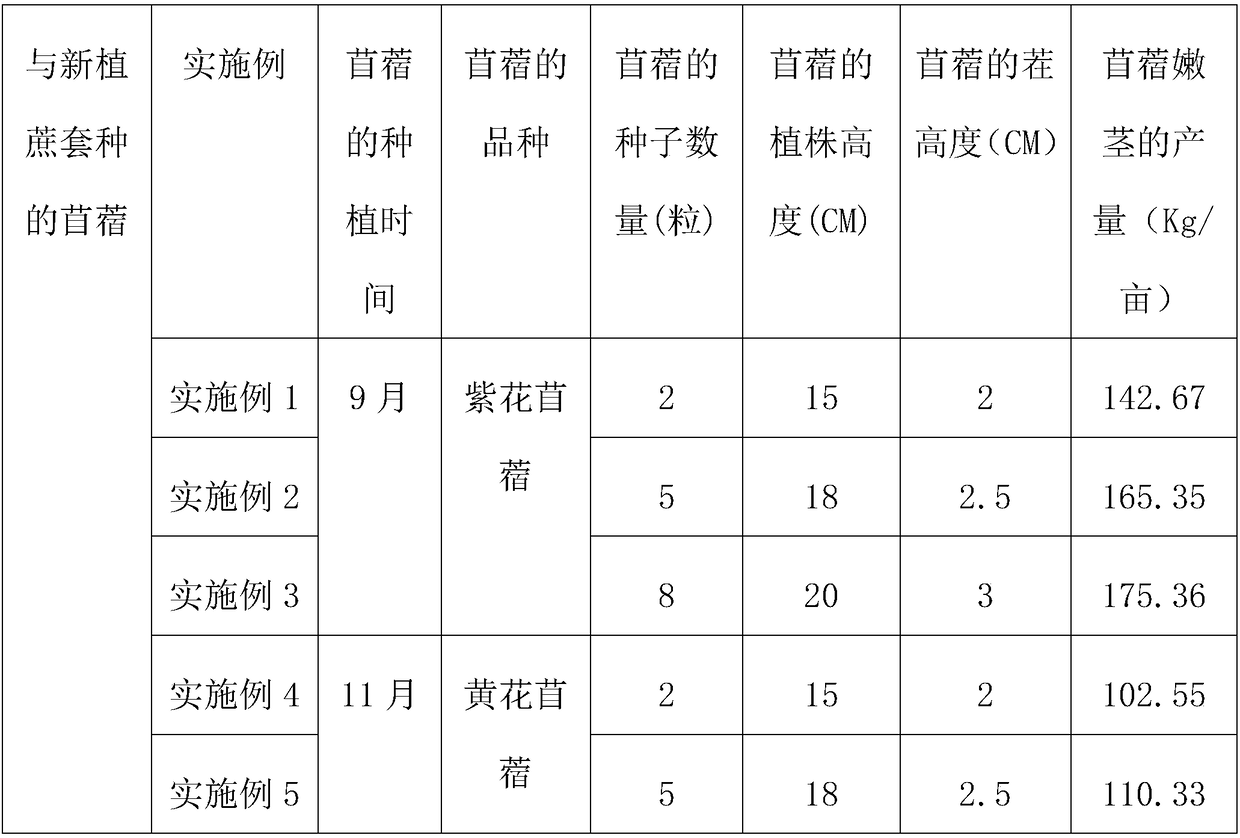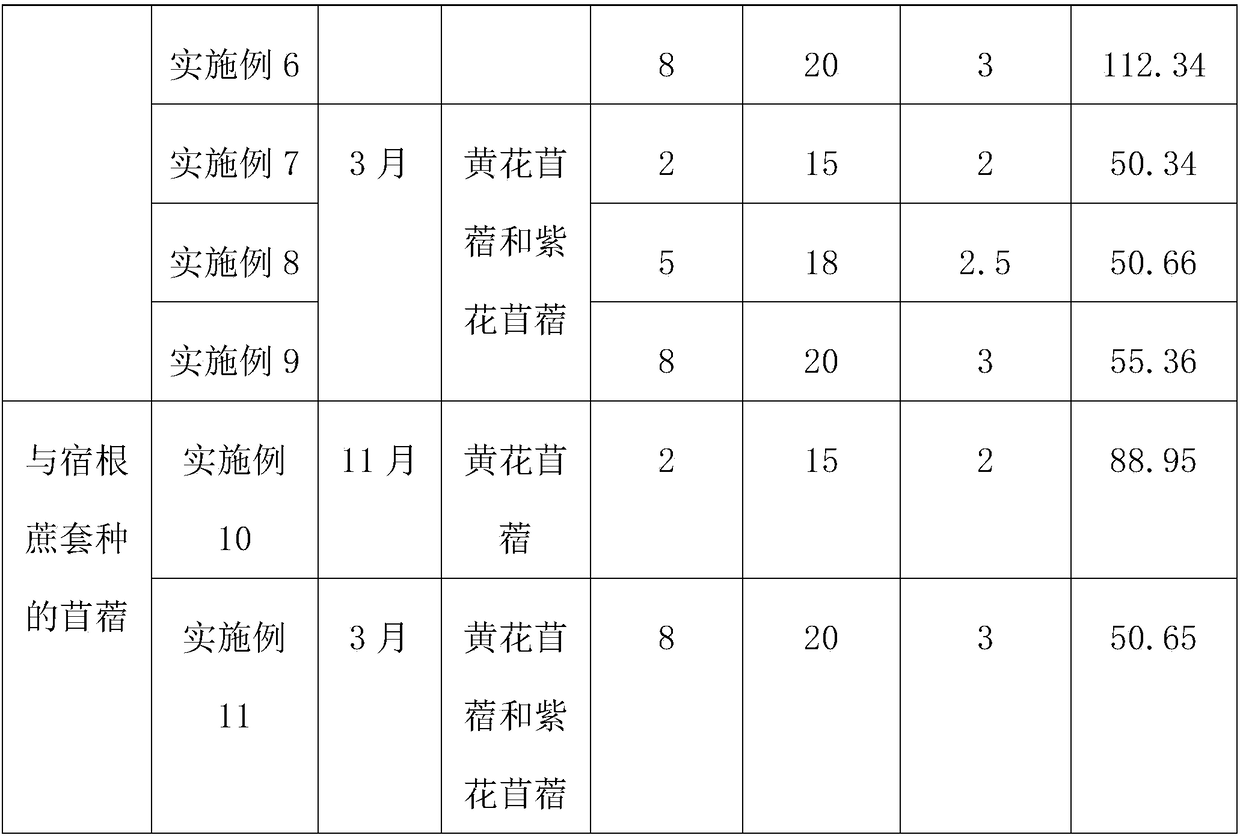Sugarcane and alfalfa interplanting method
A technology of alfalfa and sugarcane, which is applied in the fields of sugarcane cultivation, leguminous plant cultivation, organic fertilizer, etc. It can solve the problems of excessive chemical fertilizers, damage to soil structure, and long growth cycle of sugarcane, so as to improve soil structure, save fertilizer costs, The effect of increasing income
- Summary
- Abstract
- Description
- Claims
- Application Information
AI Technical Summary
Problems solved by technology
Method used
Image
Examples
Embodiment 1
[0041] A method for interplanting sugarcane and alfalfa, comprising the following steps:
[0042] The step of selecting sugarcane seedlings: sugarcane seedlings are selected as new planting cane;
[0043] The steps of planting sugarcane seedlings: planting sugarcane seedlings on the cane ridge in September;
[0044] Steps for interplanting alfalfa: Sow the seeds of alfalfa on the cane ridge in November, and cover the base of the newly planted cane. The sowing rate of alfalfa seeds is 2 seeds per square centimeter.
[0045] The steps of harvesting the young stems of alfalfa: after the young stems of the alfalfa grow from the alfalfa seeds, harvest the young stems of the alfalfa when the height of the alfalfa is 15 cm. After harvesting, the remaining stubble of the alfalfa on the ground is 2 cm.
Embodiment 2
[0047] A method for interplanting sugarcane and alfalfa, comprising the following steps:
[0048] The step of selecting sugarcane seedlings: sugarcane seedlings are selected as new planting cane;
[0049] The steps of planting sugarcane seedlings: planting sugarcane seedlings on the cane ridge in September;
[0050] The step of interplanting alfalfa: after the step of planting sugarcane seedlings is completed, immediately sow the seeds of alfalfa on the cane ridge, and cover the base of the newly planted cane. The sowing rate of alfalfa seeds is 5 seeds per square centimeter.
[0051] The steps of harvesting the young stems of alfalfa: after the young stems of the alfalfa grow from the alfalfa seeds, harvest the young stems of the alfalfa when the height of the alfalfa is 18 cm. After harvesting, the remaining stubble of the alfalfa on the ground is 2.5 cm.
Embodiment 3
[0053] A method for interplanting sugarcane and alfalfa, comprising the following steps:
[0054] The step of selecting sugarcane seedlings: sugarcane seedlings are selected as new planting cane;
[0055] The steps of planting sugarcane seedlings: planting sugarcane seedlings on the cane ridge in September;
[0056]The step of interplanting alfalfa: after the step of planting sugarcane seedlings is completed, immediately sow the seeds of alfalfa on the cane ridge, and cover the base of the newly planted cane. The sowing rate of alfalfa seeds is 8 seeds per square centimeter.
[0057] The steps of harvesting the tender stem of alfalfa: after the tender stem of the alfalfa grows from the alfalfa seed, harvest the tender stem part of the alfalfa when the height of the alfalfa is 20 cm. After harvesting, the remaining stubble of the alfalfa on the ground is 3 cm.
PUM
 Login to View More
Login to View More Abstract
Description
Claims
Application Information
 Login to View More
Login to View More - R&D
- Intellectual Property
- Life Sciences
- Materials
- Tech Scout
- Unparalleled Data Quality
- Higher Quality Content
- 60% Fewer Hallucinations
Browse by: Latest US Patents, China's latest patents, Technical Efficacy Thesaurus, Application Domain, Technology Topic, Popular Technical Reports.
© 2025 PatSnap. All rights reserved.Legal|Privacy policy|Modern Slavery Act Transparency Statement|Sitemap|About US| Contact US: help@patsnap.com


